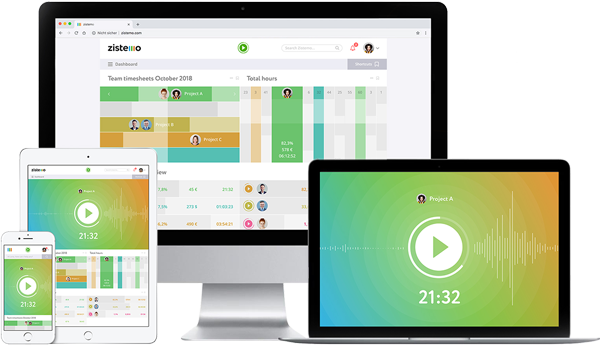Decimal Time Calculator
Use the simple zistemo time converter to calculate decimal time to hours and minutes and vice versa.

Convert time to decimal hours
Converting time values is a crucial skill in many fields. There are various types of time units. It is essential to convert them correctly in order to obtain accurate results because mostly it is employee time recorded by a time clock that needs to be calculated.
Time is an abstract concept that describes the progression of events. It can be measured using various units such as microseconds, milliseconds, seconds, minutes, hours, days, weeks, months and years. The ability to convert these units is essential to accurately represent and compare time in different contexts.
There are several formats for displaying hours and minutes
12
12-hour format
This format is widely used in the United States and Canada. To show a difference between morning and evening the 12-hour format is using AM and PM. AM means Ante meridiem and indicates the time is before noon while PM stands for Post meridiem and shows that a time is after noon. Most digital clocks showing midnight as 12:00 AM and noon as 12:00 PM.
24
24-hour Format
The 24-hour time format, also known as military time, represents hours within a range from 0 to 23, without any distinction between morning and evening. For instance, 14:30 is represented as 14:30. This format is commonly used in scientific, medical, and military contexts, as well as in many parts of Europe, Africa, Asia and the Middle East.
0,5
Decimal Time
For example, 12:30:15 is represented as 12.5025. One hour is equal to 1.0, one decimal minute is equal to 1/60, and one second is equal to 1/3600. Decimal time is convenient for mathematical calculations, but often needs to be converted back to hours and minutes for everyday usage. Decimal time format is also used to compare time durations in a decimal number.
Table of minutes and decimal time
The following table lists the minutes in the time format with the respective decimal values as a conversion chart.
| Minutes | Decimal |
|---|---|
| 00:01 | 0.0167 |
| 00:02 | 0.0333 |
| 00:03 | 0.0500 |
| 00:04 | 0.0667 |
| 00:05 | 0.0833 |
| 00:06 | 0.1000 |
| 00:07 | 0.1167 |
| 00:08 | 0.1333 |
| 00:09 | 0.1500 |
| 00:10 | 0.1667 |
| 00:11 | 0.1833 |
| 00:12 | 0.2000 |
| 00:13 | 0.2167 |
| 00:14 | 0.2333 |
| 00:15 | 0.2500 |
| 00:16 | 0.2667 |
| 00:17 | 0.2833 |
| 00:18 | 0.3000 |
| 00:19 | 0.3167 |
| 00:20 | 0.3333 |
| 00:21 | 0.3500 |
| 00:22 | 0.3667 |
| 00:23 | 0.3833 |
| 00:24 | 0.4000 |
| 00:25 | 0.4167 |
| 00:26 | 0.4333 |
| 00:27 | 0.4500 |
| 00:28 | 0.4667 |
| 00:29 | 0.4833 |
| 00:30 | 0.5000 |
| 00:31 | 0.5167 |
| 00:32 | 0.5333 |
| 00:33 | 0.5500 |
| 00:34 | 0.5667 |
| 00:35 | 0.5833 |
| 00:36 | 0.6000 |
| 00:37 | 0.6167 |
| 00:38 | 0.6333 |
| 00:39 | 0.6500 |
| 00:40 | 0.6667 |
| 00:41 | 0.6833 |
| 00:42 | 0.7000 |
| 00:43 | 0.7167 |
| 00:44 | 0.7333 |
| 00:45 | 0.7500 |
| 00:46 | 0.7667 |
| 00:47 | 0.7833 |
| 00:48 | 0.8000 |
| 00:49 | 0.8167 |
| 00:50 | 0.8333 |
| 00:51 | 0.8500 |
| 00:52 | 0.8667 |
| 00:53 | 0.8833 |
| 00:54 | 0.9000 |
| 00:55 | 0.9167 |
| 00:56 | 0.9333 |
| 00:57 | 0.9500 |
| 00:58 | 0.9667 |
| 00:59 | 0.9833 |
| 01:00 | 1.0000 |
Decimal time is primarily used in fields that require precise timekeeping, such as science, technology, mathematics and engineering. However, it is important to note that decimal time is not widely used in everyday life and is less common compared to the traditional 12-hour or 24-hour clock formats.

Amir Karahasanović
Petrolinvest
I highly recommend zistemo for its exceptional value for money

Gilles Poncin
MAQIT SA
The best about zistemo is the fast and efficient cooperation with the support team

Daniel Deutscher
DeKa Gastronomie-Treuhand
We chose zistemo because the system is so easy to use and all processes are transparent

Angelika Fite
Infrastructure Consulting & Engineering
We recommend zistemo because of the support team — quick to respond and provide quick resolution

Martin Domenig
Kohl & Partner
Since we started using zistemo, we have much less effort for time and expense tracking

Marcus König
targenio
We love to use the zistemo features and our employees don’t see time tracking as punishment

Dennis Stogl
Stogl Robotics
Zistemo works very coherently and is very easy to use even with complex projects

Andreas Pfister
All Around Digital
It is the most complete tool on the market for agencies like us

Ruben Maier-Gerber
FFI Agentur GmbH
Proximity to the user and always an open ear for improvements

Enrico Aramini
HTC High Tech Consultant Corp
Zistemo’s flexibility, parametric customization and user’s access control won us from day 1

André Kälin
Perspectix
The very fact not wasting a single minute unbilled is worth its price

Priska Stamm
Softsolution International
We really couldn’t ask for a better invoicing solution!

Fabian Bergner
LUX FUX Media
With better business intelligence, we can offer better and more efficient services

Hendrik Huerkamp
slashwhy GmbH & Co. KG
I thoroughly recommend zistemo for the people behind it and the clever features

Terence Hänni
Megasol Energie AG
Zistemo gives structure to the company and is transparent for all users
Time Conversion Factors
Of course, there are many units and formats for times, but the ones mentioned above are the most common. Let's consider how does the time conversion work specifically to convert decimal hours to other time formats with hours minutes and seconds.
How do I calculate decimal time?
Converting hours and minutes into a decimal number is not complicated and almost no calculator is needed. The time zone doesn't matter because the decimal system always represents a duration and not a specific point in time. The formula for this is:
Number of minutes/60 = Conversion of hours and minutes to decimal
Converting a small unit of time into a larger unit
In general, when converting from a smaller unit of time to a larger one, division is necessary. To convert from seconds to minutes, the number of seconds is divided by 60. Similarly, to convert minutes to hours, the number of minutes is divided by 60. The result is a decimal number and can be easily converted to the 24-hour format. For example:
30 seconds = 30/60 = 0.5 minutes
55 minutes = 55/60 = 0.917 hours
When converting hours to days, the process is different. The number of hours must be divided by 24 as there are 24 hours in a day.
12 hours = 12/24 = 0.5 days
Converting a large unit of time into a smaller unit
To convert a large unit of time into a smaller unit, the conversion factor must be multiplied. For example, to convert hours to minutes, the number of hours is multiplied by 60.
4 hours = 4x60 = 240 minutes
Development of the 24-hour time format
The system of dividing a day into 24 equal hours, each hour into 60 minutes, and each minute into 60 seconds, has its roots in ancient civilizations of Egypt and Greece. Throughout history, this system has been refined and developed further. In its earliest forms, the day was divided into 12 hours which were used to measure both daytime and nighttime. Later, these 12 hours were divided into smaller units of time. The ancient Romans advanced this concept by basing it on the position of the sun, allocating 12 hours for daylight and 12 hours for nighttime.
As clock-making technology advanced during the Middle Ages, more precise clocks were created, resulting in more accurate timekeeping. The invention of pendulum clocks in the 17th century, followed by the development of spring-driven and quartz clocks, greatly improved the precision of measuring time units.
The origin of the decimal system
The decimal system is a number system that utilizes 10 digits, from 0 to 9. The reason for its creation is likely due to the fact that humans have ten fingers which made it more convenient for them to work with a number system based on 10. Some scholars argue that it was used by ancient cultures in different parts of the world, while others suggest that it was developed more recently.
A decimal number of hours allows time to be expressed as a fraction of a day, enabling mathematical comparison, data analysis and calculations with other numerical values. For example, calculating the duration between two specific points in time in hours or minutes. Representing time in decimal format simplifies the process of calculating the difference between values and eliminates the need to convert them into hours and minutes. Additionally, the decimal format is more convenient to present and analyze time data in tables, charts and graphs.

Summary
The 12-hour or 24-hour format is the most commonly used in daily life, as it provides a clear and convenient way to express a specific time. To perform mathematical calculations with time, it is recommended to use decimal hours, which requires converting units. The process of converting time is not uncommon and similar to converting other units of measurement such as weight or length. There are various online calculators available, such as the one on this page for converting minutes to decimal time, which can assist with the conversion process. Often they are referred as a duration calculator or hours calculator. The key to achieving a successful conversion is using the correct conversion factors and having a thorough understanding of the units being converted.
Calculate Hourly Salary
Instantly determine the total time worked on a project. Keep it simple and professional. Work smarter, not harder!
Start your 14 day free trial
